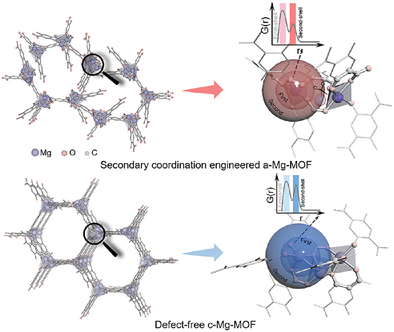Regulated Second-sphere Coordination in Amorphous Metal-organic Framework for Efficient CO2 Fixation
Graphical Abstract
Second-sphere coordination regulation strategy is employed by atomically tailoring the metal–metal coordination of the secondary building unit (SBU), with efforts to trigger more orbital interactions with guest molecules. Amorphous metal-organic framework (a-MOF) is chosen to transform rigid trinuclear nodes into flexible dinuclear motifs. Such architecture with clear and unique second-sphere interaction can open spatial proximity to access the guest molecule and optimize s–π* overlap by enabling orbital reorientation.
Abstract
The endeavor toward photocatalytic CO2 fixation is largely hampered by the rigid spatial configurations and inadequate orbital overlap between the catalytic site and CO2. Herein, we propose a second-sphere coordination regulation strategy by atomically tailoring the metal–metal coordination of the secondary building unit (SBU). Amorphous metal-organic framework (a-MOF) is constructed as proof-of-concept to achieve creative control over the second coordination sphere. Such architecture transforms rigid trinuclear nodes into flexible dinuclear motifs. This shift can open spatial proximity to access the guest molecules and optimize s–π* overlap by enabling orbital reorientation. Both in situ experiments and theoretical calculations verify second-sphere engineering endows the Lewis base sites with high electron donating capacity and promotes the electron injection into the π* anti-bonding orbitals of the CO2 molecule effectively. Hence, the a-MOF displays approximately double the yield in various photocatalytic CO2 reactions compared with its crystalline counterpart. Moreover, its photo-assisted Li-CO2 battery delivers higher discharging voltage and a fourfold increment of discharge capacity at 200 µA cm−2. The unique ability to tailor the secondary coordination sphere performs attractive merits governing the small molecule binding affinity, aiming to manipulate the local microenvironment of open metal sites for efficient CO2 fixation.
Conflict of Interests
The authors declare no conflict of interest.
Open Research
Data Availability Statement
The data that support the findings of this study are available from the corresponding author upon reasonable request.





